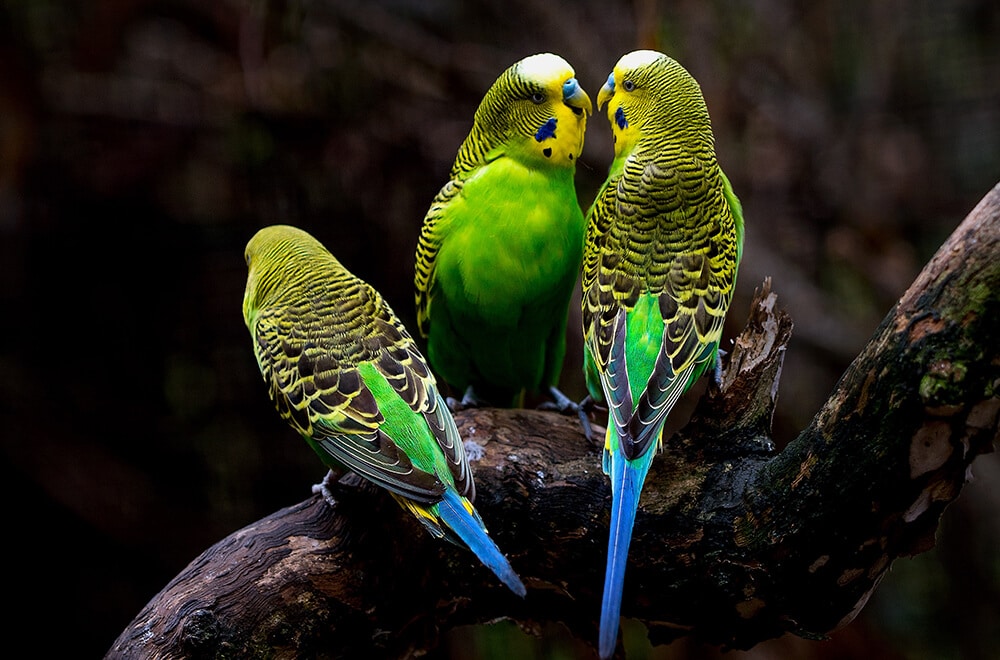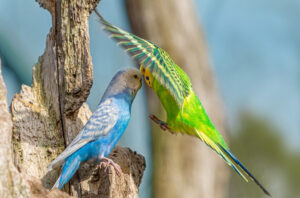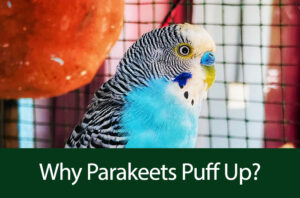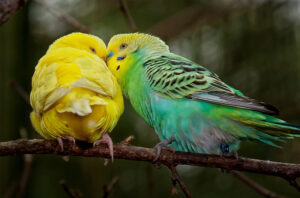Are you looking to bring some joy in your home? If you are a caring & loving person, a colorful Australian parakeet can be the most beautiful decision.
Australian parakeet, which is known as budgerigar or budgie is a small, intelligent and adorable bird that can bring happiness in any home with their charming colors and voice.
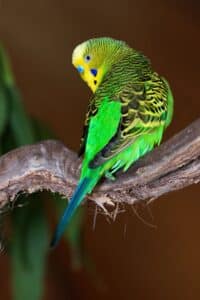
They are native to the drier parts of Australia. In the wild they usually travel for food and water in large groups, bonding together in flocks. On average, they measures about 18 cm (7 inches) long, weight between 30-40 grams and on average 30 cm (12 inches) in wingspan.
Whether you already have an Australian Parakeet or you are looking forward to, you might discover some interesting facts by reading this article.
Quick information about the Australian Parakeet
- Scientific name:Melopsittacus Undulatus
- Common names:Budgerigar (budgie)
- Average life span: 5-10 years
- Relative size: 18 cm (7 inches)
- Weight: 30-40 grams
- Egg clutch: 4-6 eggs
- Color: Budgies are divided into two series of colors:
- White-based: skyblue, cobalt, mauve, gray, violet, and white.
- Yellow-based: light-green, dark-green, gray-green, olive, and yellow.
Interesting facts
- A budgie can have up to 3,000 feathers in total across their whole body.
- They are the most popular type of pet bird. In fact, 45% of pet birds in the United States are budgies.
- A third, rarely visible eyelid keeps a budgie’s eyes clean and lubricated.
- The Australian budgie is usually a few inches smaller than the English budgie.
- The budgerigar has a surprisingly high respiration rate of up to 85 breaths per minute.
- Budgies can move each eye independently of the other and see out of each eye independently. This is called monocular vision.
- They have hollow bones which are filled with air sacs to aid flight.
- The shells of a budgie’s eggs are covered with tiny pores which enable oxygen and carbon dioxide to pass through.
- Budgies have highly acute vision and can register over 150 images per second.
- All budgie colors originate from the green and yellow budgie. The first color mutation to appear reportedly was the yellow bird with faint green suffusion in 1872.
- Budgies can talk, and males usually have a larger vocabulary than females. Males have been reported to speak up to one thousand words.
- Their beaks grow 3 inches a year.
Species varieties
Opaline budgies: this species of budgie has the entire head colored in shades related to the face color, except for a small patch over each year. The rump is the same color as the back, and there is a large amount of red on the tail feathers.
Spangle budgies: they have fewer throat spots than others. Budgies with two spangle genes are predominantly one colour, yellow or white, sometimes with other tones subtly suffusing the plumage.
Yellow-face budgies: this type of budgie have yellow faces, rather than white. The yellow is confined to the face, wing edges and tail.
Clearbody budgies: they are basically white or yellow, with the usual black pattern on the wings, but with pale grey primary feathers. They also have variety of colour, depending on their ancestry.
Crested budgies: they have tufts and crests that obscure their faces entirely, occasionally creating a bizarre ‘flower face’ effect.
Looking to know more? Read about different type of parakeets and how to take care of a budgie for better insights.
Diet – What does Australian Parakeet love to eat?
A budgie show always be taken care of and a variety of foods should be provided. For a healthy budgie you should always ensure that your budgie is eating healthy.
Don’t forget to feed your lovely birds with fruits and vegetables.
A perfect budgie diet not only means the right amount of food, but also the right combination of the essential nutrients. Find out below some ideas of what your budgie might love.
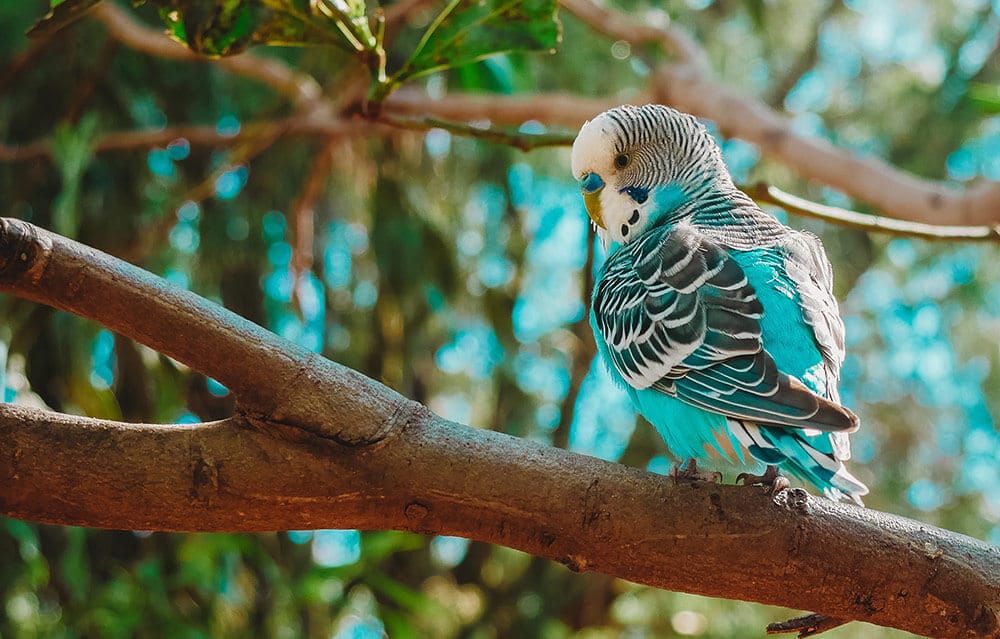
Meals which contains a variety of seeds and some fresh fruits or vegetables define a balanced diet.
The food needs to contain proteins, carbohydrates, vitamins and minerals. Keep in mind that the budgie needs varied food in order to stay healthy.
You can read more about budgie diet and everything you need to know.
Do not feed your budgie with avocado! It contain persin, a toxic and lethal chemical to birds.
Fruits that budgies loves to eat:
- Banana – high in potassium
- Grapefruit – high in vitamin A
- Orange – high in vitamin C
- Blueberry/blackberry – high in antioxidants
- Papaya – high in vitamin A
- Peach – high in vitamin C
- Mango – high in vitamin A
- Apple – high in vitamin C
Healthy vegetables for your budgie:
- Tomato – high in vitamin A
- Cucumber – high in potassium and fiber
- Carrot – very high in vitamin A
- Spinach – high in antioxidants
- Broccoli – high in potassium
- Peas – high in potassium
- Salad – high in vitamin A and C
Avoid feeding your budgie with the below, can be toxic to your little bird.
- Avocado
- Onions and garlic
- Chocolate
- Tulip
- Potato plants
- Apple seeds
- Beans
- Cheese
- Biscuits
- Mushrooms
How to take care of an Australian Parakeet?
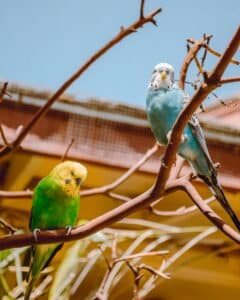
Budgies are small birds that are relatively easy to look after. They are known as being great daily companions.
When it comes to caring for Australian Parakeets, their charismatic personalities and vibrant plumage make the experience even more rewarding. Providing a spacious and stimulating environment is key, ensuring they have room to fly, explore, and play.
Offering a balanced diet rich in seeds, fresh fruits, and vegetables contributes to their health and vitality. Regular social interaction and mental stimulation through toys and engaging activities foster their happiness and prevent boredom.
Remember, building a bond with your Australian Parakeet requires patience and consistency, and in return, you’ll be rewarded with their cheerful presence and delightful chirps echoing through your home.
If you want your budgie to be healthy and happy, here are a few tips:
- You need a big cage for your budgie. Every bird should have space to play and stretch their wings. Keep in mind not to buy a circular cage, they will feel insecure, as it has no corners to hide in. The cage should be at least 50 centimeter (19.7 in) D x 60 centimeter (23.6in) H x 80 centimeter (31.5in) W.
- Cage placement: It is recommended to place the cage in an accessible area (budgies loves the interaction and feel comfordable when are people around).
- Budgie love toys. Toys are important to the mental and physical health of a budgie. Interacting with a toy does not only stimulates their mind, but it will also keep your budgie active and engaged. A variety of toys such as swings, bells, balls, mirror etc. will keep your little budgie entertained and happy.
- Keep in mind that your parakeet need space to move freely in the cage, so the number of the toys should be proportional with cage size.
- Food and water. Budgie should have a varied diet that is made up of various seeds, vegetables and fruits. A good nutrition is supplemented by fresh water, so make sure the water is changed daily.
- Talk and play with your parakeet. Budgies are social little birds and they need companionship. It is recommended to spend time playing with your budgie daily.
- Budgies enjoys the time out of the cage. Every parakeet enjoys flying and exploring. If you decide to let your budgies out, please ensure that there are no open windows or other hazards that may harm your budgie.
Taking care of a budgie must be a responsibility but at the same time very enjoyable and relaxing for you, as a little-bird owner.
Australian Parakeet, as pets
Bred in captivity since the middle 1800’s, budgies are the most popular and common pets around the world. Usually they are very playful and active birds that enjoys to socialize with people around them. Budgies bring happiness in every home!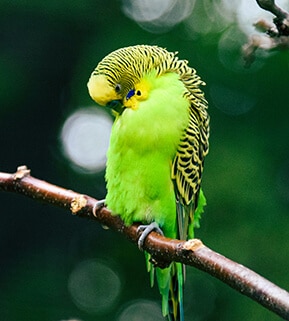
Budgies has the ability to talk and chat. In fact, parakeets have broken world records for having the largest bird vocabulary. A budgerigar named Puck holds the world record for the largest vocabulary of any bird, at 1,728 words.
If you already have a budgie, seven ways to keep your budgie happy can be a helpful article to brighten your day.
Australian Parakeet in wildness
In the wildness, budgerigars are noticeably smaller than those in captivity and they are predominantly green.
Wild budgerigars are nomadic birds found in open habitats, primarily in Australian scrubland and they rarely interact with people.
Breeding Australian Parakeets
People often ask “how hard is to breed budgies?” and the answer is quite simple. If you love what you do, breeding budgies will bring a lot of joy and happiness in your life!
A female reaches sexual maturity early, around 3-4 months, but mating is not recommended earlier than 10-11 months. An underdeveloped bird can be affected and it may have difficulties in expelling the eggs.
The mating period begins in mid-February and ends in April. The female begins to lay eggs at 8-10 days after settling with the nest.
Reproduction of the budgie will be successfully and healthy if several environmental conditions are met:
- The space in the cage. For a pair of budgies, the cage must have at least the dimensions: 62 x 30 x 45 centimeters.
- Temperature.The appropriate temperature for the reproduction of the budgie must be between 21 and 23 degrees Celsius.
- Light positively influences hormonal activity, so these cheerful birds should enjoy it for about 12 hours a day.
- Nest. The nest of these birds are generally intimate and usually have the shape of a cube. The dimensions should be at least 14 x 18 x 25 centimeters. One of the nest sides should be removable to facilitate it’s cleaning. As for the nest “floor”, it must be provided with a recess for the eggs to stand in one place.
How to identify the gender of an Australian Parakeet?
There are several ways to identify the gender of a budgie but the most common method is to identify it by the color and the appearance of the cere of the budgie.
The adult male budgie has a blue cere while the adult female has a pinkish-brown cere. Note: this is only true for adult parakeets. Young parakeets have a blue cere regardless of their gender.
Color of the cere give us an idea about the gender of the budgie, however, its appearance may change with breeding season, age of the bird, and the health of the bird.
How much does an Australian Parakeet cost?
Due to their smaller size, they are a good choice for new bird owners. The cost of a parakeet will vary depending on where you purchase the bird. They will typically cost between $10 to $60.
Adopting an Australian Parakeet
Australian parakeets are fairly common all over the world and they can be adopted, purchased, or rescued at verified organizations such as RescueParrots.org or on some adoption sites like Petfinder.
Australian parakeets are very lovely pets and deserves to be loved. These cute birds will bring lots of happiness and joy into your life. Taking care of your budgie should be your daily routine, in return, budgies will brighten your day with their special voice and personality, everyday.

